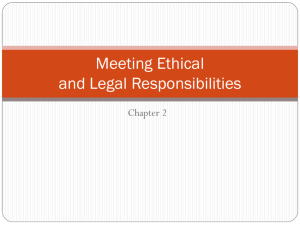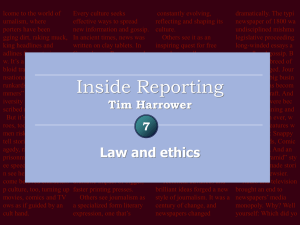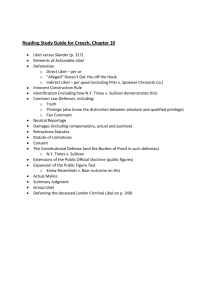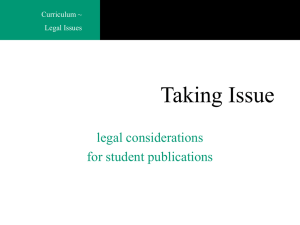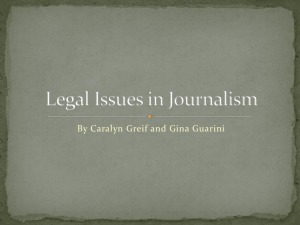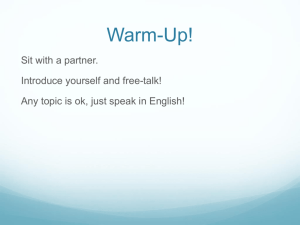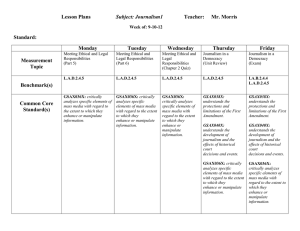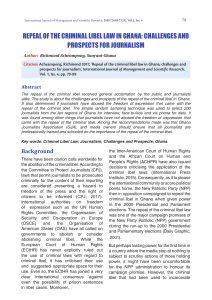WRITING FOR THE MASS MEDIA
advertisement
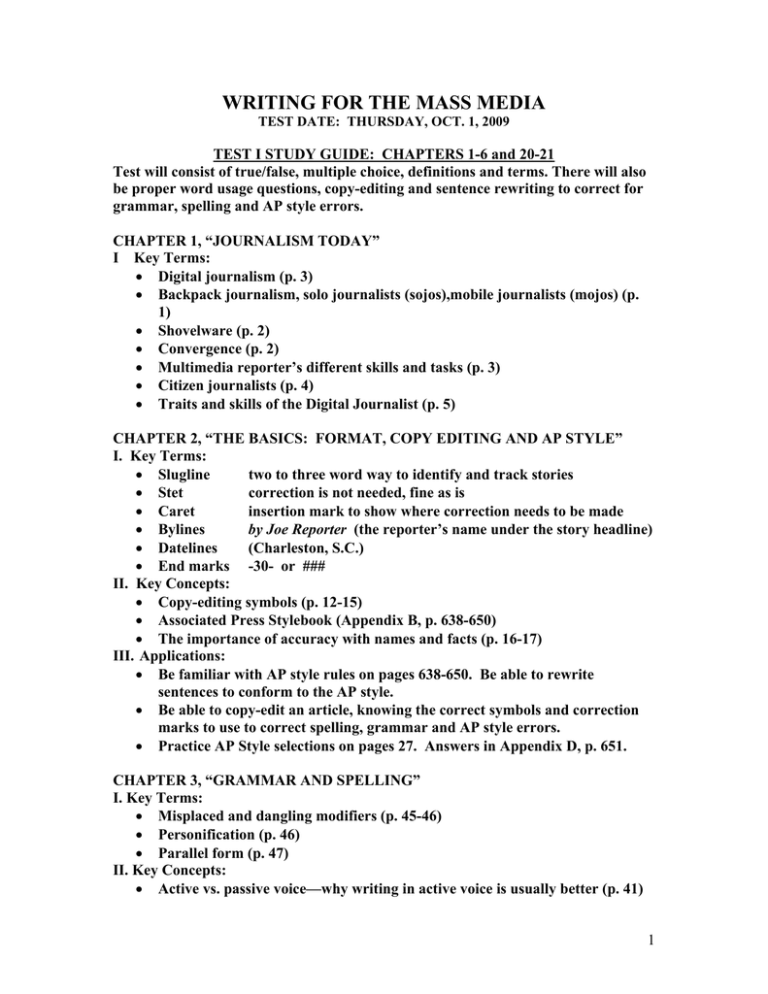
WRITING FOR THE MASS MEDIA TEST DATE: THURSDAY, OCT. 1, 2009 TEST I STUDY GUIDE: CHAPTERS 1-6 and 20-21 Test will consist of true/false, multiple choice, definitions and terms. There will also be proper word usage questions, copy-editing and sentence rewriting to correct for grammar, spelling and AP style errors. CHAPTER 1, “JOURNALISM TODAY” I Key Terms: • Digital journalism (p. 3) • Backpack journalism, solo journalists (sojos),mobile journalists (mojos) (p. 1) • Shovelware (p. 2) • Convergence (p. 2) • Multimedia reporter’s different skills and tasks (p. 3) • Citizen journalists (p. 4) • Traits and skills of the Digital Journalist (p. 5) CHAPTER 2, “THE BASICS: FORMAT, COPY EDITING AND AP STYLE” I. Key Terms: • Slugline two to three word way to identify and track stories • Stet correction is not needed, fine as is • Caret insertion mark to show where correction needs to be made • Bylines by Joe Reporter (the reporter’s name under the story headline) • Datelines (Charleston, S.C.) • End marks -30- or ### II. Key Concepts: • Copy-editing symbols (p. 12-15) • Associated Press Stylebook (Appendix B, p. 638-650) • The importance of accuracy with names and facts (p. 16-17) III. Applications: • Be familiar with AP style rules on pages 638-650. Be able to rewrite sentences to conform to the AP style. • Be able to copy-edit an article, knowing the correct symbols and correction marks to use to correct spelling, grammar and AP style errors. • Practice AP Style selections on pages 27. Answers in Appendix D, p. 651. CHAPTER 3, “GRAMMAR AND SPELLING” I. Key Terms: • Misplaced and dangling modifiers (p. 45-46) • Personification (p. 46) • Parallel form (p. 47) II. Key Concepts: • Active vs. passive voice—why writing in active voice is usually better (p. 41) 1 • Common writing mistakes with subject-verb agreement and noun-pronoun agreement (p. 41-42). Example: Which is correct? “A team of researchers have been gathering the information” or “A team of researchers has been gathering the information.” Or “Notre Dame has won their fifth game in a row” or “Notre Dame has won its fifth game in a row.” III. Applications: • Correct sentences with agreement, misplaced modifiers, personification, noun-pronoun agreement, and parallel form errors. • Review rewrite exercises on pages 49-51. Corrections are in back of book on pages 651-653. CHAPTER 4: “NEWSWRITING STYLE” I. Key Terms: • Prewriting: Identifying the Central Point (p. 65-66) • Objectivity (p. 72-73) II. Key Concepts: • Research on readability and words per sentence (p. 68) • Avoid stereotyping in terms of writing, i.e. racism, sexism, ageism (p. 73-76) III. Applications: • Correct sentences to make less wordy • Rewrite sentences eliminating exclusively male nouns and pronouns, stereotypical language and comments • Review Exercise 5 on pages 92-94. Answers in back of book pages 653-654 CHAPTER 5, “THE LANGUAGE OF NEWS” I. Key Terms: (know meanings and be able to identify examples of each) • Cliché (p. 99 and list on page 101—be able to list several clichés) • Slang (p. 102) • Jargon (p. 102) • Euphemisms (p. 103) • Platitudes (p. 104) • Gush (p. 106) II. Key Concepts: • Using words effectively and precisely (pages 95-98) III. Applications: • Knowing the differences between words with similar meanings and spellings • Avoiding clichés, slang, jargon, etc. (see key terms listed above) • Review Exercise 6, pages 121-123. Answers in back, pages 655-656 CHAPTER 6, “SELECTING AND REPORTING THE NEWS” I. Key Terms: • Timeliness, Impact, Prominence, Proximity, Singularity, Conflict and Controversy (Characteristics of News, p. 128-133) • “Hard News” and “Soft News” (p. 133-134) 2 II. Key Concepts: • Details Newspapers (and other news media) are Reluctant to Publish: such as sensationalism, rumors, names of rape victims, names of juvenile suspects/offenders (p. 136-139) III. Applications: • Deciding what is newsworthy/ranking newsworthiness • What details and facts to include and what not to include in news stories CHAPTER 20, “LIBEL, PRIVACY AND NEWSGATHERING ISSUES” I. Know meanings of: • Libel, slander, defamation (p. 544-545) • Six things a plaintiff in a libel lawsuit must prove (p. 545-549) • “Actual malice” (p. 550) • Three major defenses to libel suits (p. 551-553) • Four kinds of invasion of privacy (p. 556-561) • “Intrusion” (p. 556) • “Appropriation” (p. 561) • The Freedom of Information Act (FOIA) (p. 563) • The Sunshine Act (p. 564) • Shield laws (p. 569) II. Understand a reporter’s rights regarding access to news scenes, records, meetings and judicial proceedings (p. 562-566) III. Understand, for journalists, the importance of protecting confidential sources and information (p. 567-569) IV. Review 12 Steps for Avoiding Libel Suits (p. 555-556) V. Review Checklists that cover chapter’s key material (p. 570-571) VI. Review and be able to list several “Red Flag” Words (see website) VII. Review Libel and Privacy Lawsuit Media Components and Defenses (website) CHAPTER 21, “ETHICS” • Understand the importance of media credibility (p. 578) • Review the “guiding questions” that reporters should ask themselves when faced with ethical dilemmas or situations. (p. 578) • “Macro” and “Micro” Issues (p. 580) • Maintaining Objectivity (p. 586) • Review “Ethical Issues” concerning reporting/exploiting grief, interviewing victims, visuals (newsworthy or sensational?), invasion of privacy issues, deciding when to use names (p. 587-592) • Review issue of “posing” and the use of hidden cameras and tape recorders (p. 593) • Review ABC/Food Lion case (p. 593) • Review the problems with reporting rumors (p. 594) • Review conflict of interest situations—accepting gifts, trips, etc. (p. 584-58 • Review the Society of Professional Journalists Code of Ethics (website) ### 3 4
